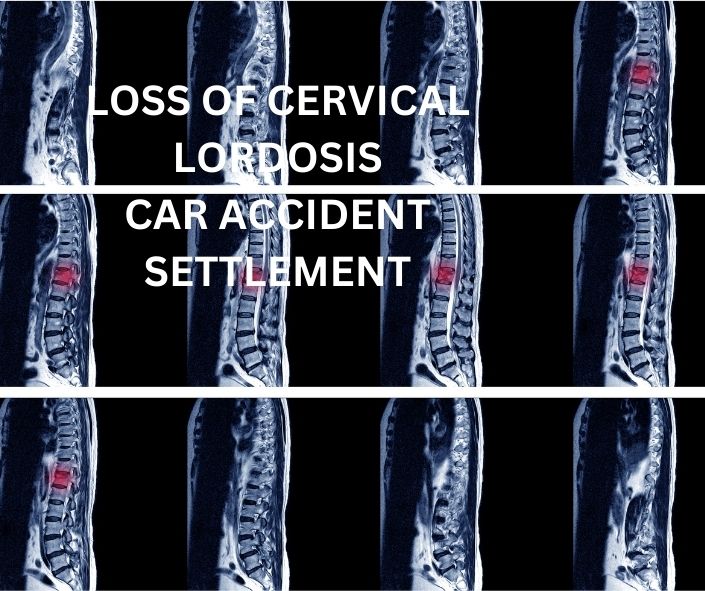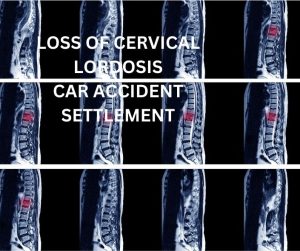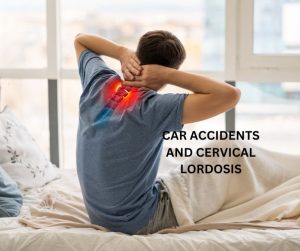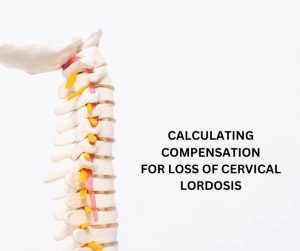Loss of Cervical Lordosis | Car Accident Settlements

Author: 30klife January 22, 2024
Car accidents, often unexpected and traumatic, can lead to a variety of injuries, some of which have long-lasting impacts. One such condition that can arise from these incidents is the loss of cervical lordosis. This blog post aims to explore the complexities of loss of cervical lordosis caused by car accidents, the legal avenues for seeking compensation, and the importance of understanding both the medical and legal aspects of this condition for an effective settlement claim.
Understanding Loss of Cervical Lordosis
Cervical lordosis refers to the natural inward curve of the neck. This curvature is crucial for proper balance and distribution of weight within the spinal column. When this curve is reduced or lost, often referred to as “loss of cervical lordosis,” it can lead to various physical complications, including pain, stiffness, and limited mobility. This condition can profoundly impact an individual’s quality of life, often necessitating medical treatment and potentially leading to chronic discomfort.
Symptoms of loss of cervical lordosis can vary but often include neck pain, numbness in the hands or arms, muscle weakness, and in severe cases, changes in gait or coordination. Understanding these symptoms is crucial for early diagnosis and treatment. For those involved in car accidents, it’s important to seek medical evaluation if any of these symptoms are present, as they could indicate the development or exacerbation of cervical lordosis issues.
What is the evidence of loss of cervical lordosis?
 The evidence of loss of cervical lordosis is primarily obtained through medical evaluation and diagnostic imaging. Loss of cervical lordosis refers to a straightening or reversal of the normal curve of the cervical spine (the neck region). This condition can lead to various symptoms and complications, and its diagnosis is typically based on the following:
The evidence of loss of cervical lordosis is primarily obtained through medical evaluation and diagnostic imaging. Loss of cervical lordosis refers to a straightening or reversal of the normal curve of the cervical spine (the neck region). This condition can lead to various symptoms and complications, and its diagnosis is typically based on the following:
- Clinical Evaluation:
- Symptoms: Patients may report neck pain, stiffness, headaches, and sometimes radiating pain or numbness in the arms. These symptoms often prompt further investigation.
- Physical Examination: A doctor will perform a physical examination, looking for limitations in the range of motion, areas of tenderness, and any neurological deficits that might be associated with changes in the cervical spine.
- Radiological Imaging:
- X-rays: The most direct evidence for loss of cervical lordosis comes from X-ray images of the neck. These images can show a straightened cervical spine, where the normal inward curve is reduced or absent.
- MRI and CT Scans: More detailed imaging like Magnetic Resonance Imaging (MRI) or Computed Tomography (CT) scans may be used to assess any associated conditions, such as disc herniation or spinal cord compression. These scans provide more detail about the soft tissues, including the spinal cord and nerves.
- History of Trauma or Injury (if relevant):
- In cases where loss of cervical lordosis is suspected to be due to an injury, such as a car accident, the patient’s medical history becomes crucial. Information about any recent trauma, the nature of the injury, and the onset of symptoms can support the diagnosis.
- Assessment of Posture and Ergonomics:
- Poor posture or prolonged abnormal positioning (like working at a computer for extended periods) can contribute to or exacerbate loss of cervical lordosis. An assessment of these factors might be part of the evaluation process.
- Correlation of Symptoms with Imaging Findings:
- It’s essential to correlate clinical symptoms with findings on imaging to ensure that the loss of cervical lordosis is responsible for the symptoms. In some cases, individuals may have a straightened cervical spine on imaging but no symptoms.
- Follow-up Imaging:
- In some cases, follow-up imaging may be necessary to observe any changes in the spinal curvature over time, especially if there is ongoing treatment or therapy.
- Consultation with Specialists:
- Consultations with neurologists, orthopedic surgeons, or spine specialists might be required for a comprehensive assessment, especially in cases with neurological symptoms or significant pain.
Proper diagnosis and evidence gathering for loss of cervical lordosis are important not only for medical treatment but also in legal contexts, such as personal injury claims following accidents. Medical documentation and expert opinion play a crucial role in these situations.
Car Accidents and Cervical Lordosis
 Car accidents, particularly those involving sudden impacts or whiplash motions, can be a significant factor in the loss of cervical lordosis. The force exerted on the neck during an accident can damage the muscles, ligaments, and vertebrae, leading to a change in the neck’s natural curvature. Rear-end collisions are notably associated with this, as the abrupt forward and backward movement can strain the cervical spine.
Car accidents, particularly those involving sudden impacts or whiplash motions, can be a significant factor in the loss of cervical lordosis. The force exerted on the neck during an accident can damage the muscles, ligaments, and vertebrae, leading to a change in the neck’s natural curvature. Rear-end collisions are notably associated with this, as the abrupt forward and backward movement can strain the cervical spine.
In the aftermath of a car accident, it’s crucial to document all aspects of the incident and any immediate health concerns. This documentation should include details of the accident, medical reports immediately following the incident, and any symptoms related to the neck or spine. This information can be vital for future medical assessments and legal claims.
Diagnosing Loss of Cervical Lordosis Post-Accident
Diagnosing loss of cervical lordosis involves a thorough medical evaluation, often including imaging tests like X-rays, CT scans, or MRIs. These diagnostic tools are critical in assessing the curvature of the spine and identifying any changes post-accident. A timely and accurate diagnosis not only aids in effective treatment but also serves as essential evidence if a legal claim is pursued.
Individuals involved in a car accident should seek prompt medical attention, even if symptoms are not immediately evident. It’s also important to follow through with recommended diagnostic tests and treatments, as these medical records will form the foundation of any claim related to the condition.
Legal Considerations for Settlement Claims
When pursuing a settlement claim for loss of cervical lordosis following a car accident, establishing a direct link between the accident and the condition is essential. This can be challenging, as insurers and legal entities may scrutinize the claim, especially if there were pre-existing neck issues.
Enlisting the help of a personal injury lawyer experienced in spinal injuries can be invaluable. They can assist in gathering the necessary medical evidence, obtaining expert medical opinions, and effectively communicating the extent of the injury and its impact on your life. The legal process will likely involve detailed medical assessments and possibly expert testimony to establish the connection between the car accident and the loss of cervical lordosis.
Calculating Compensation in Loss of Cervical Lordosis Cases
 Compensation in cases of loss of cervical lordosis due to a car accident is typically based on several factors. These include incurred medical costs, both current and future; lost wages if the condition affects your ability to work; and pain and suffering. Additionally, the settlement may consider the cost of ongoing treatments, such as physical therapy or chiropractic care, and any necessary adaptations to your home or lifestyle.
Compensation in cases of loss of cervical lordosis due to a car accident is typically based on several factors. These include incurred medical costs, both current and future; lost wages if the condition affects your ability to work; and pain and suffering. Additionally, the settlement may consider the cost of ongoing treatments, such as physical therapy or chiropractic care, and any necessary adaptations to your home or lifestyle.
It’s important to maintain detailed records of all medical treatments, lost income, and how the condition has impacted your daily life. These records will be crucial in settlement negotiations, helping to ensure that the compensation reflects the true cost of the injury.
Case Studies and Precedents
Reviewing previous cases of loss of cervical lordosis settlements can offer valuable insights. Understanding how similar cases were handled, the types of evidence that were influential, and the settlement amounts awarded can provide a benchmark for your expectations. Legal precedents, particularly in your jurisdiction, can also guide your case, offering a glimpse into how courts have historically viewed and valued such claims.
Long-Term Management and Support
Living with loss of cervical lordosis post-accident often requires long-term management. This may include regular medical check-ups, ongoing physical therapy, and possibly lifestyle adjustments to accommodate limited mobility or chronic pain. Emotional and psychological support are also important, as dealing with a chronic condition can be mentally taxing.
Developing a comprehensive long-term care plan with your healthcare provider is important. This plan should address not only the physical aspects of the condition but also the emotional and psychological impacts. Involving a therapist or counselor can be beneficial in coping with the changes brought about by the injury.
Auto Accident Injury Attorney Near Me
The journey to a fair settlement for loss of cervical lordosis following a car accident involves understanding the medical complexities of the condition, navigating the legal landscape, and advocating for the full impact of the injury on your life. It’s a path that requires careful documentation, expert medical and legal assistance, and an awareness of the long-term implications of the condition.
If you or someone you know is facing the challenge of a loss of cervical lordosis due to a car accident, it’s important to seek professional advice. Engage with medical professionals for proper diagnosis and treatment, and consult with legal experts to understand your rights and options for compensation. Remember, you are not alone in this journey, and there are resources available to help you navigate this challenging time.
You might also be interested in…
- Neck Injury Settlement Calculator
- Car Accident Knee Surgery Settlement
- Guide to Fibromyalgia Car Accident Settlements
- Lower Back Pain Car Accident Settlements
- Average Payout for T-Bone Accident
Cervical Lordosis FAQs
Can a car accident cause cervical lordosis?
A car accident can indeed cause changes in the cervical spine, including the development or worsening of cervical lordosis. However, it’s important to understand the specifics of how such an incident can impact the spine.
Understanding Cervical Lordosis
Cervical lordosis refers to the natural inward curve of the cervical spine (the neck region). This curve is important for maintaining balance and absorbing shock. The loss of this natural curvature, often referred to as “loss of cervical lordosis,” “straightening of the cervical spine,” or “cervical kyphosis,” can lead to various symptoms like pain, stiffness, and reduced mobility.
Impact of Car Accidents
- Whiplash and Trauma: Car accidents, especially rear-end collisions, can cause whiplash injuries, where the head is suddenly jerked backward and then forward. This violent motion can strain the muscles and ligaments of the neck, potentially leading to alterations in the cervical spine’s curvature.
- Acute Injuries: The force exerted during a car accident can also cause more acute injuries to the cervical spine, including fractures or dislocations, which can subsequently alter the cervical lordosis.
- Exacerbation of Pre-existing Conditions: If an individual already has a compromised cervical spine due to pre-existing conditions like degenerative disc disease, a car accident can exacerbate these issues, potentially leading to further loss of the normal cervical curvature.
Symptoms and Diagnosis
After a car accident, symptoms such as neck pain, stiffness, headaches, and restricted range of motion can indicate cervical spine issues. Diagnosing changes in cervical lordosis typically involves a physical examination and imaging studies like X-rays or MRIs.
Treatment and Recovery
Treatment for changes in cervical lordosis due to a car accident can vary depending on the severity. It may include physical therapy, pain management, chiropractic care, or in severe cases, surgery. Recovery can vary, with some individuals experiencing long-term symptoms.
Legal and Insurance Aspects
In the context of a car accident, proving that the incident caused a change in cervical lordosis can be crucial for insurance and legal claims. Medical documentation, evidence from the accident, and expert testimonies play vital roles in establishing this link.
In summary, a car accident can cause or exacerbate cervical lordosis. It’s important for anyone involved in a car accident experiencing neck pain or related symptoms to seek medical attention promptly. Not only is this important for health and recovery, but it also assists in documenting the injury for any potential insurance or legal claims.
Can a car accident make degenerative disc disease worse?
Yes, a car accident can potentially make degenerative disc disease (DDD) worse. Degenerative disc disease, a condition characterized by the breakdown or degeneration of the intervertebral discs in the spine, can be exacerbated by the trauma and forces involved in a car accident. Here’s how:
Impact of Car Accidents on Degenerative Disc Disease
- Increased Stress on Discs: The sudden jolts and impacts experienced in a car accident can place additional stress on the spine. For individuals with pre-existing DDD, this can accelerate the degeneration process or worsen existing damage.
- Exacerbation of Symptoms: Even if the degeneration itself is not significantly advanced by the accident, the symptoms associated with DDD, such as pain, stiffness, and reduced mobility, can be intensified.
- Inflammation and Further Damage: The trauma from a car accident can lead to inflammation and irritation in and around the spinal discs. This can exacerbate the pain and discomfort associated with DDD.
- Hidden Effects: Sometimes, the full impact of a car accident on degenerative disc disease may not be immediately apparent. Symptoms can worsen gradually over time, making it essential to monitor one’s condition closely after an accident.
Diagnosis and Treatment
Following a car accident, individuals with pre-existing DDD should seek a thorough medical evaluation. Diagnostic tools like X-rays, MRI scans, or CT scans can help assess any changes or worsening in the condition. Treatment may involve physical therapy, pain management techniques, chiropractic care, or, in more severe cases, surgical interventions.
Legal and Insurance Considerations
In the context of legal and insurance claims, demonstrating that a car accident has worsened degenerative disc disease can be complex. It involves:
- Medical Documentation: Detailed medical records both before and after the accident are crucial. They can help establish a baseline of the DDD’s severity prior to the accident and demonstrate any subsequent exacerbation.
- Expert Testimony: Medical experts can provide insights into how the accident may have impacted the condition.
- Consistency and Continuity of Care: Regular follow-ups and consistent treatment help to document the progression of the condition and its link to the accident.
Importance of Early Intervention
For individuals with degenerative disc disease, the impact of a car accident should not be underestimated. Early intervention, both medically and legally, is key to managing the condition and addressing any related claims. Continuous monitoring and documentation are essential for both health outcomes and any potential compensation related to the worsening of the condition.
Can whiplash cause loss of normal cervical lordosis?
Yes, whiplash can cause loss of normal cervical lordosis. Whiplash is a neck injury commonly associated with rear-end car collisions, where the head is suddenly jerked backward and then forward. This rapid motion can strain the neck muscles and ligaments, potentially leading to various spinal issues, including changes in the curvature of the cervical spine.
Understanding the Impact of Whiplash on Cervical Lordosis
- Muscle Strain and Spasm: Whiplash can cause muscles in the neck to strain or spasm. This reaction can temporarily or sometimes permanently change the alignment of the neck, leading to a loss of the normal cervical lordosis.
- Ligament Damage: The ligaments in the neck, which help maintain spinal alignment, can be overstretched or torn during a whiplash injury. This can compromise the structural integrity of the cervical spine, potentially leading to an altered curvature.
- Disc Injuries: Whiplash can also affect the intervertebral discs in the cervical spine. Disc herniations or bulges resulting from the injury can contribute to a loss of normal cervical curvature.
- Long-term Effects: Initially, the loss of cervical lordosis after a whiplash injury may be due to muscle spasms or acute inflammation. However, if the injury leads to chronic pain or ongoing spinal issues, this can result in a more permanent change in the neck’s curvature.
Symptoms and Diagnosis
The loss of normal cervical lordosis due to whiplash can manifest in various symptoms, including neck pain and stiffness, headaches, and reduced range of motion. Diagnosis typically involves a physical examination, and imaging tests like X-rays or MRIs to assess the spinal alignment and identify any associated injuries such as disc herniations or ligament damage.
Treatment and Recovery
Treatment for loss of cervical lordosis following a whiplash injury may include physical therapy, chiropractic care, pain management, and in some cases, orthopedic intervention. The goal is to reduce pain, restore normal neck function, and, if possible, the natural cervical curvature.
Recovery time can vary, with some individuals experiencing symptoms for a prolonged period. It’s important to follow a comprehensive treatment plan and attend regular follow-up appointments to monitor progress.
Legal and Insurance Aspects
In cases where whiplash and subsequent loss of cervical lordosis are due to a car accident, legal and insurance considerations come into play. Documenting the accident, injury, and medical treatment is crucial, especially if seeking compensation. This documentation should include medical records, imaging results, and records of any treatments related to the injury.
In summary, whiplash can indeed cause a loss of normal cervical lordosis, leading to a range of symptoms and requiring a comprehensive approach to treatment and recovery. For those involved in car accidents, understanding the potential for this type of injury, seeking prompt medical attention, and documenting all relevant information are key steps in managing both the health and legal aspects of the injury.

 Car accidents, particularly those involving sudden impacts or whiplash motions, can be a significant factor in the loss of cervical lordosis. The force exerted on the neck during an accident can damage the muscles, ligaments, and vertebrae, leading to a change in the neck’s natural curvature. Rear-end collisions are notably associated with this, as the abrupt forward and backward movement can strain the cervical spine.
Car accidents, particularly those involving sudden impacts or whiplash motions, can be a significant factor in the loss of cervical lordosis. The force exerted on the neck during an accident can damage the muscles, ligaments, and vertebrae, leading to a change in the neck’s natural curvature. Rear-end collisions are notably associated with this, as the abrupt forward and backward movement can strain the cervical spine. Compensation in cases of loss of cervical lordosis due to a car accident is typically based on several factors. These include incurred medical costs, both current and future; lost wages if the condition affects your ability to work; and pain and suffering. Additionally, the settlement may consider the cost of ongoing treatments, such as physical therapy or chiropractic care, and any necessary adaptations to your home or lifestyle.
Compensation in cases of loss of cervical lordosis due to a car accident is typically based on several factors. These include incurred medical costs, both current and future; lost wages if the condition affects your ability to work; and pain and suffering. Additionally, the settlement may consider the cost of ongoing treatments, such as physical therapy or chiropractic care, and any necessary adaptations to your home or lifestyle.
 The evidence of loss of cervical lordosis is primarily obtained through medical evaluation and diagnostic imaging. Loss of cervical lordosis refers to a straightening or reversal of the normal curve of the cervical spine (the neck region). This condition can lead to various symptoms and complications, and its diagnosis is typically based on the following:
The evidence of loss of cervical lordosis is primarily obtained through medical evaluation and diagnostic imaging. Loss of cervical lordosis refers to a straightening or reversal of the normal curve of the cervical spine (the neck region). This condition can lead to various symptoms and complications, and its diagnosis is typically based on the following: